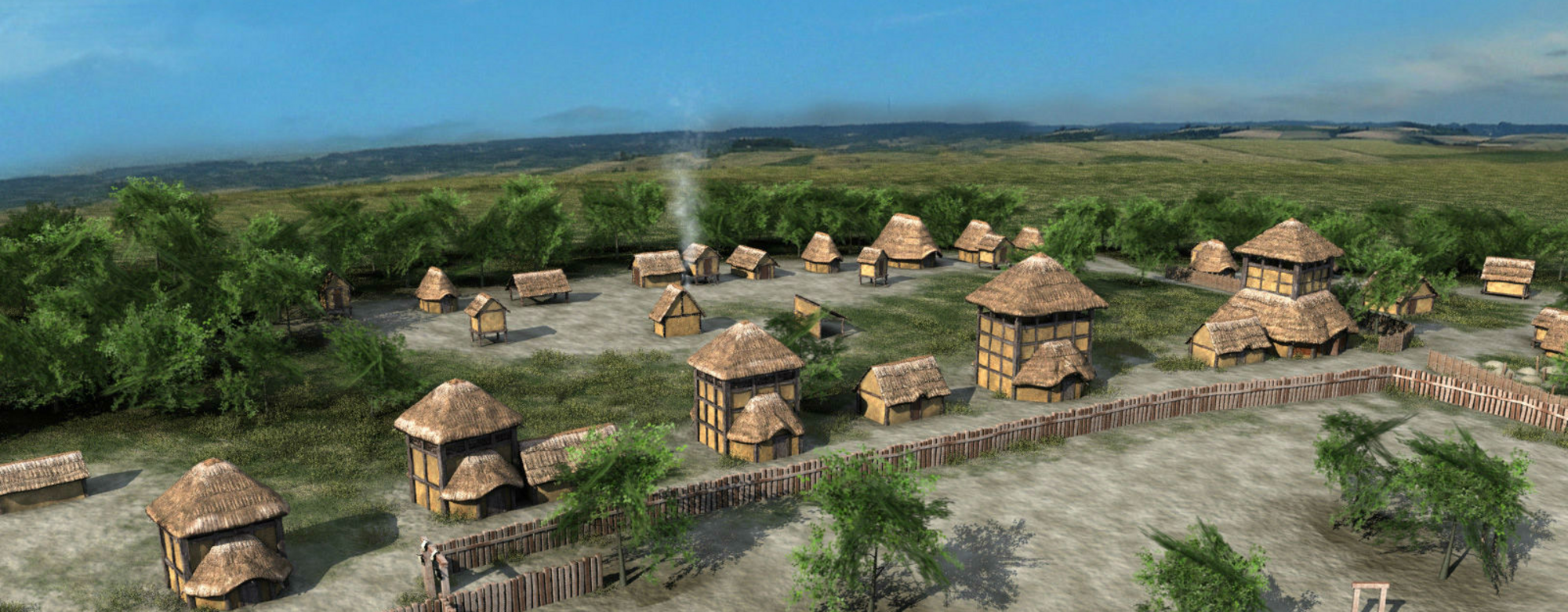
- Home
- The Gallic village
- Establishing the village
- The community and religious space
The square ran along the last contour line of the plateau and the whole settlement was organised around it. The long west side measured 85 metres, the short south side measured 24.5 metres and at its widest point it was 56.5 metres within the curve of the D. The posts of the palisade set into the ditch have been recovered, with bones of animals slaughtered in this space which had fallen into these holes. Bull skulls were hung over the entrance on the south side. In the southern half, cattle bones were in the majority, whereas on the north side, the bones were mainly horse. This is also the place where some human remains were discovered (teeth, the tops of skulls).
The square was enclosed by a strong wooden fence, and the only way in was through a gate in the south side which separated the area from the secular village. Animals, cattle and horses, were slaughtered and butchered here. This was probably the location for banquets, public meetings, trading, fairs and markets.
The construction of five buildings parallel to the long west side of the square required a precise geometric layout in accordance with a preconceived plan. Their dimensions and spacing show a regular geometric progression with a multiplying factor of 1.25. The heights calculated based on this number produced a unique set of monuments situated at the highest point of the plateau in the centre of the village. In the largest building (No. IV), 11 m x 10 m, a square well was dug, 7.60 metres deep, with a very specific function (the water table is at a depth of 60 metres!). The specificity of these constructions, their siting, their indisputable relationship with the square and the presence of unusual styles of human burials nearby indicate that these buildings had a ritual function.
The well
It was dug precisely on the longitudinal axis and 2.5 metres from the entrance. At the top the remains of a wooden frame are still visible, which held the top layers of crumbling chalk in place. One post was placed at the north side of this coping. At 2.14 metres from the bottom of the well the sides narrowed, forming two ledges on the side with notches in the wall. These were designed to support two wooden beams. The walls were carefully finished with an adze 9 cm wide.
Corpses buried in a rolled position
In front of large building IV, nineteen bodies were found buried on an esplanade enclosed by a palisade, a path and other structures. They had the unusual feature of being in a sitting position with their heads on their feet. They had been rolled into a ball and placed in shallow circular graves. Their hip bones indicate that eight of them were adult males. Meticulous study has shown that these corpses were buried after being dried, probably a form of natural mummification.
This exceptional discovery, unique at the time it was made, gave rise to a great many interpretations and comments. Since then, other individuals buried in this way have been found in several locations.
Sacrificial victims?
The skeletons are quite worn away and there is nothing to show how these people died. They were naked and no grave goods had been placed with them when they were buried. Each skeleton occupied precisely the same tiny amount of space and several show the effects of a cramped burial. Once the different elements had been carefully studied and the archaeological evidence had been placed in context, the conclusions indicated a specific ritual. The deceased had been placed in a box with the same dimensions as the well in the large building. The box was then lowered into the well and left there for a certain period of time. Once the body was completely dry it was removed and placed in a grave in front of the religious building. This operation could only be carried out in winter, for obvious reasons (no flies, etc.). The number of bodies and the ritual indicate regular sacrifices which ceased when the religious buildings and the large square were abandoned and the well was filled in, in about 100/80 BC.
Associated media
Open Media Library

Alignements des temples

Entrée de la grande cour

Village d'Acy-Romance

Espace communautaire et religieux

Grand temple

Plan et coupe du puits

Paroi du puits

Ressauts et fond du puits

Plan de situation des roulés en boule

Inhumé roulé en boule

Fosses des défunts roulés en boule

Inhumé recroquevillé

Mains d'un inhumé recroquevillé

Position des recroquevillés

